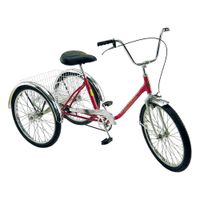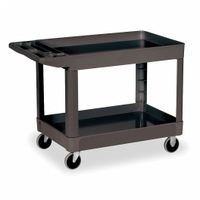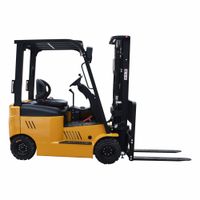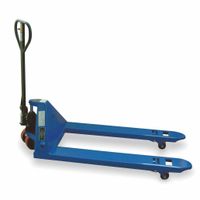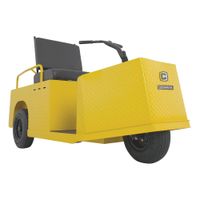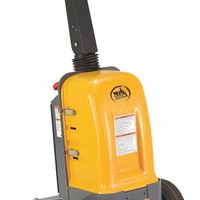Call +(254) 703 030 000 / 751 483 999 / 721 704 777
- Home
- Material Handling
- Transporting
.....Read More
Frequently Asked Questions
What are the best practices for safely transporting heavy equipment and materials?
1. **Planning and Assessment**: Conduct a thorough risk assessment to identify potential hazards. Plan the route, considering road conditions, weather, and any obstacles.
2. **Proper Training**: Ensure all personnel involved in the transport are adequately trained in handling heavy equipment and materials. This includes understanding load limits, securing techniques, and emergency procedures.
3. **Use of Appropriate Equipment**: Select the right transport vehicles and equipment, such as cranes, forklifts, or flatbed trucks, based on the weight and dimensions of the load.
4. **Load Securing**: Use high-quality securing devices like chains, straps, and binders to prevent movement during transit. Follow the load securing guidelines and ensure the load is evenly distributed.
5. **Weight and Dimension Compliance**: Adhere to legal weight limits and dimension regulations to avoid fines and ensure safety. Obtain necessary permits for oversized loads.
6. **Regular Maintenance**: Ensure all transport vehicles and equipment are regularly inspected and maintained to prevent mechanical failures.
7. **Communication**: Maintain clear communication among all team members, including drivers, operators, and supervisors, to coordinate movements and address any issues promptly.
8. **Safety Gear and Signage**: Equip personnel with appropriate safety gear, such as helmets and reflective vests. Use warning signs and lights on transport vehicles to alert other road users.
9. **Escort Vehicles**: For oversized or heavy loads, use escort vehicles to guide the transport and manage traffic, ensuring a safe passage.
10. **Emergency Preparedness**: Have an emergency plan in place, including contact information for emergency services and procedures for dealing with accidents or breakdowns.
11. **Documentation**: Keep all necessary documentation, such as permits, licenses, and inspection reports, readily available for verification by authorities.
12. **Post-Transport Review**: Conduct a review after transport to identify any issues and improve future practices.
How do I choose the right type of cart or truck for my needs?
Choosing the right cart or truck depends on several factors, primarily the nature of the items you need to transport, the environment in which the transport will occur, and the frequency and distance of transport.
First, consider the items: their weight, size, shape, and fragility. Heavy or bulky items might require a platform truck or a flatbed cart, while smaller, numerous items might be better suited for a utility cart with multiple shelves or bins. Fragile items could benefit from carts with cushioning or enclosed designs.
Next, evaluate the environment. Will you be moving items indoors on smooth surfaces, or outdoors over rough terrain? Indoor use might be fine with hard wheels, but outdoor applications often necessitate pneumatic tires for better shock absorption and traction. Also, consider aisle widths and door clearances; some larger trucks may not fit in tight spaces.
Finally, think about how often and how far you'll be transporting. For frequent, long-distance hauling, an ergonomic hand truck or a powered industrial truck (like a forklift or pallet jack) might be more efficient. For occasional, short-distance moves, a basic utility cart or hand truck could suffice.
Other considerations include material (steel for durability, aluminum for lightweight, plastic for chemical resistance), braking systems, and specialized features like foldability for storage or specific attachments for unique items. Always prioritize safety and ensure the chosen equipment has a weight capacity suitable for your heaviest loads.
What are the benefits of using casters and wheels on equipment?
Casters and wheels offer numerous benefits when used on equipment, enhancing functionality, efficiency, and safety. Firstly, they provide mobility, allowing heavy or bulky equipment to be easily moved from one location to another. This mobility reduces the physical strain on workers, minimizing the risk of injury and increasing productivity.
Secondly, casters and wheels improve space utilization. Equipment can be easily repositioned to optimize workspace layout, facilitating better organization and workflow. This flexibility is particularly beneficial in dynamic environments like warehouses, hospitals, and manufacturing facilities where space and layout needs frequently change.
Thirdly, they contribute to equipment longevity. By enabling smooth movement, casters and wheels reduce wear and tear on both the equipment and the flooring. This can lead to lower maintenance costs and extend the lifespan of the equipment.
Additionally, casters and wheels enhance safety. Many are designed with locking mechanisms to secure equipment in place, preventing accidental movement. This is crucial in environments where stability is essential, such as in medical settings or on uneven surfaces.
Furthermore, they offer versatility. Casters and wheels come in various sizes, materials, and designs to suit different applications and environments. For instance, rubber wheels provide quiet operation and floor protection, while steel wheels offer durability for heavy-duty applications.
Lastly, they can improve efficiency. By facilitating quick and easy movement, casters and wheels can significantly reduce the time and effort required for tasks such as cleaning, maintenance, and equipment reconfiguration, leading to more streamlined operations.
In summary, the use of casters and wheels on equipment enhances mobility, space utilization, equipment longevity, safety, versatility, and operational efficiency, making them a valuable addition to various industries.
How do conveyors improve efficiency in material handling?
Conveyors significantly enhance efficiency in material handling by streamlining the movement of goods, reducing manual labor, and minimizing errors. They provide a continuous and automated method of transporting materials, which accelerates the handling process and increases throughput. By automating the movement of items, conveyors reduce the need for human intervention, thereby decreasing labor costs and the potential for human error. This automation ensures a consistent and reliable flow of materials, which is crucial for maintaining production schedules and meeting delivery deadlines.
Conveyors also improve safety in the workplace by reducing the need for workers to manually lift, carry, or transport heavy or bulky items, thereby minimizing the risk of injuries. They can be customized to fit specific operational needs, handling a wide range of materials, from small parts to large packages, and can be integrated into existing systems to optimize workflow.
Moreover, conveyors can be designed to operate in various environments, including those with extreme temperatures or hazardous conditions, ensuring that material handling is efficient regardless of the setting. They can also be equipped with sensors and control systems to monitor and manage the flow of materials, further enhancing efficiency by preventing bottlenecks and ensuring that the right materials are delivered to the right place at the right time.
In addition, conveyors contribute to better space utilization within a facility. By transporting materials overhead or along designated paths, they free up valuable floor space for other operations, which can lead to increased productivity. Overall, conveyors are a vital component in modern material handling systems, offering a combination of speed, reliability, and flexibility that significantly boosts operational efficiency.
What factors should be considered when selecting a dolly or mover?
1. **Weight Capacity**: Ensure the dolly or mover can handle the weight of the items you need to transport. Overloading can lead to equipment failure or accidents.
2. **Type of Load**: Consider the nature of the items (e.g., fragile, bulky, or irregularly shaped) to choose a dolly with appropriate support features like straps or padding.
3. **Terrain and Environment**: Assess the surfaces over which the dolly will be used. For rough or uneven terrain, opt for larger wheels or pneumatic tires for better maneuverability.
4. **Size and Dimensions**: The dolly should fit through doorways and tight spaces. Measure the items and the pathways to ensure compatibility.
5. **Material and Durability**: Choose a dolly made from durable materials like steel or aluminum for heavy-duty use, or lightweight materials like plastic for lighter loads.
6. **Ease of Use**: Look for features like ergonomic handles, swivel wheels, or foldable designs for easy operation and storage.
7. **Cost**: Balance your budget with the dolly’s features and durability. Investing in a quality dolly can save money in the long run by reducing the risk of damage to items or the dolly itself.
8. **Safety Features**: Consider dollies with brakes, non-slip surfaces, or safety straps to secure loads and prevent accidents.
9. **Brand Reputation and Reviews**: Research brands and read customer reviews to gauge reliability and performance.
10. **Purpose and Frequency of Use**: For frequent or professional use, invest in a high-quality, durable dolly. For occasional use, a basic model may suffice.
11. **Storage Space**: Consider where you will store the dolly when not in use. Compact or foldable designs are ideal for limited storage space.
How do hand trucks differ from dollies, and when should each be used?
Hand trucks and dollies are both material handling tools, but they differ in design and use.
Hand trucks, also known as two-wheelers or sack trucks, have a vertical L-shaped frame with two wheels at the base and a small platform or toe plate. They are designed to be tilted back, allowing the load to rest against the frame while being moved. Hand trucks are ideal for transporting smaller, stackable items like boxes, appliances, or furniture over short distances. They are particularly useful for navigating narrow spaces, stairs, and curbs due to their upright design and maneuverability.
Dollies, on the other hand, are flat platforms with four wheels, often without handles. They come in various forms, such as furniture dollies, which are low to the ground and have a larger surface area, and appliance dollies, which may include straps for securing items. Dollies are best suited for moving large, heavy, or bulky items like pianos, large furniture, or multiple boxes at once. They are ideal for use on flat, smooth surfaces and are less suited for stairs or uneven terrain.
In summary, use a hand truck when you need to move smaller, stackable items over short distances, especially in tight spaces or on stairs. Opt for a dolly when transporting large, heavy, or bulky items across flat surfaces.
What are self-dumping hoppers, and how do they work?
Self-dumping hoppers are specialized containers designed for efficient material handling and waste management. They are commonly used in industrial, construction, and manufacturing environments to collect, transport, and dump various bulk materials such as scrap metal, waste, aggregates, and recyclables.
The "self-dumping" mechanism is their key feature. These hoppers are engineered with a pivoted base and a weighted front, which causes the hopper to tilt forward and empty its contents when a latch or release mechanism is engaged. This operation is typically triggered when the hopper is lifted by a forklift or other lifting equipment, and a release lever or chain makes contact with the forklift mast or an operator activates it. As the hopper tips, its contents are discharged, and once empty, the hopper automatically returns to its upright, locked position due to its balanced design. This design eliminates the need for manual tipping, reducing labor, improving safety, and increasing efficiency in material handling processes.
What are the key differences between forklifts and lift trucks?
Forklifts and lift trucks are both essential pieces of equipment used in material handling, but they have distinct differences in terms of design, functionality, and application.
1. **Design and Structure**:
- **Forklifts**: Typically have a more robust and complex design, featuring a mast, forks, and a counterweight at the rear. They are designed to lift heavy loads vertically and transport them over short distances.
- **Lift Trucks**: A broader category that includes various types of material handling equipment, such as pallet jacks, stackers, and reach trucks. They may not always have a counterweight and can vary significantly in design.
2. **Functionality**:
- **Forklifts**: Primarily used for lifting and moving heavy loads. They can handle a wide range of weights and are equipped with hydraulic systems for precise lifting and lowering.
- **Lift Trucks**: Serve various purposes depending on the type. For example, pallet jacks are used for moving pallets, while reach trucks are designed for high stacking in narrow aisles.
3. **Capacity and Range**:
- **Forklifts**: Generally have higher load capacities, often ranging from 1,500 to over 30,000 pounds, making them suitable for industrial applications.
- **Lift Trucks**: Capacity varies widely. Pallet jacks may handle up to 5,500 pounds, while other types like order pickers have lower capacities.
4. **Application**:
- **Forklifts**: Commonly used in warehouses, manufacturing plants, and construction sites where heavy lifting is required.
- **Lift Trucks**: Used in a variety of settings, including retail, warehouses, and distribution centers, often for more specific tasks like order picking or narrow aisle navigation.
5. **Mobility and Maneuverability**:
- **Forklifts**: Offer greater stability and power but may be less maneuverable in tight spaces.
- **Lift Trucks**: Often designed for enhanced maneuverability, especially in confined areas.
In summary, while all forklifts are lift trucks, not all lift trucks are forklifts. The choice between them depends on the specific material handling needs and operational environment.
How do pallet jacks and container tilters operate?
Pallet jacks and container tilters are essential tools in material handling, each serving distinct purposes.
Pallet jacks, also known as pallet trucks, are used to lift and move pallets. They operate using a hydraulic pump mechanism. The operator inserts the forks of the pallet jack under the pallet. By pumping the handle, hydraulic fluid is compressed, which raises the forks and lifts the pallet off the ground. The operator can then push or pull the pallet jack to transport the load. Pallet jacks come in manual and electric versions, with electric models offering powered lifting and movement, reducing physical strain on the operator.
Container tilters, on the other hand, are designed to tilt containers for easier access to their contents. They operate using hydraulic or electric systems to tilt containers to a desired angle, typically up to 90 degrees. The operator places the container on the tilter platform, secures it, and activates the tilting mechanism. This tilting action allows for ergonomic access to the contents, reducing the need for bending or reaching. Container tilters are particularly useful in manufacturing and assembly environments where frequent access to parts or materials is required.
Both pallet jacks and container tilters enhance efficiency and safety in material handling. Pallet jacks streamline the movement of heavy loads, while container tilters improve accessibility and reduce the risk of injury from manual handling.
What are the advantages of using powered cargo carriers in a warehouse setting?
Powered cargo carriers offer several advantages in a warehouse setting:
1. **Increased Efficiency**: They significantly speed up the transportation of goods within the warehouse, reducing the time taken to move items from one location to another.
2. **Enhanced Productivity**: By automating the movement of cargo, workers can focus on other tasks, thereby increasing overall productivity.
3. **Reduced Labor Costs**: Fewer manual laborers are needed for moving heavy loads, which can lead to a reduction in labor costs.
4. **Improved Safety**: Powered carriers reduce the risk of injuries associated with manual lifting and carrying of heavy items, promoting a safer work environment.
5. **Consistent Performance**: These carriers provide consistent and reliable performance, minimizing the risk of human error and ensuring that operations run smoothly.
6. **Scalability**: They can be easily integrated into existing warehouse systems and scaled up as the business grows, accommodating increased volumes of goods.
7. **Space Optimization**: Powered carriers can navigate narrow aisles and tight spaces more efficiently than manual methods, optimizing the use of available space.
8. **Versatility**: They can handle a wide range of cargo types and sizes, making them suitable for various warehouse operations.
9. **Energy Efficiency**: Modern powered carriers are designed to be energy-efficient, reducing the overall energy consumption of warehouse operations.
10. **Data Integration**: Many powered carriers come with advanced tracking and data integration capabilities, allowing for better inventory management and real-time monitoring of goods.
11. **Reduced Downtime**: With regular maintenance, powered carriers can operate with minimal downtime, ensuring continuous workflow.
12. **Environmental Benefits**: Electric-powered carriers produce fewer emissions compared to traditional fuel-powered vehicles, contributing to a greener warehouse environment.
